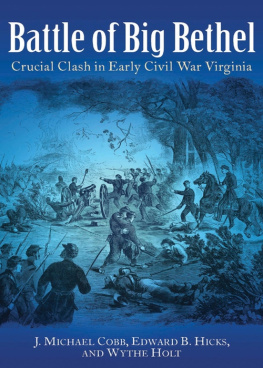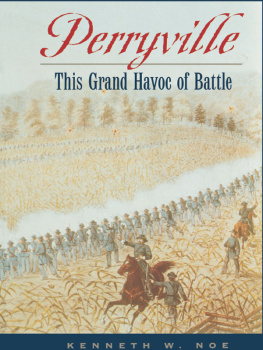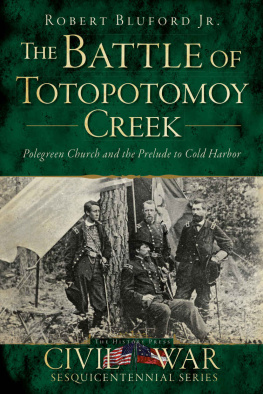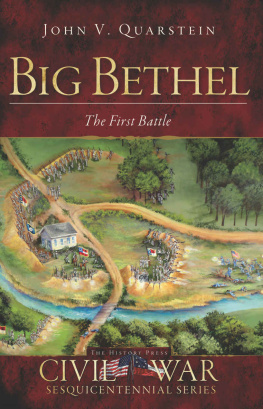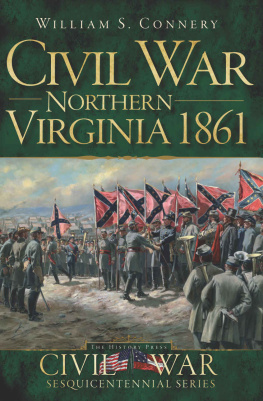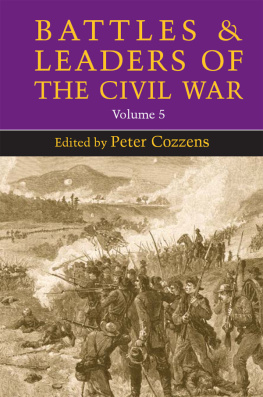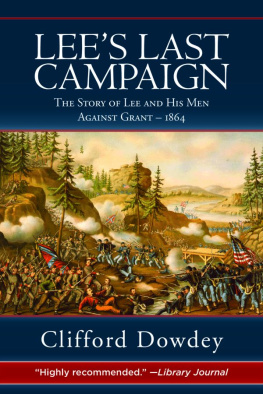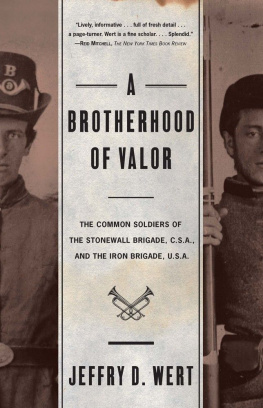The acuracy of the fire of Parrot guns or rifled canon & its terible, destructive force was conspicious. At each fire, the solid columns would open forty yards. I saw where [a shot] passed through the walls of a house [then] through the bodies of 2 poor Yankees mangling them horibly. An old gentleman heard an officer remark that the devil was the artilerist managing that rifle.
Captain Edward R. Young, Mount Vernon Guards, writing in his diary on August 6, 1861 Michael F. Geisinger, transcriber, Civil War Papers of Edward Rush Young
(Vernon Hill, Va.: Michael F. Geisinger, 1994)
You defeat the enemy with a pickax.
Corbulo, Roman general, quoted in Frontinus, Stratagems, 4.7.2

2013 by J. Michael Cobb, Edward B. Hicks and Wythe Holt
All rights reserved. No part of this publication may be reproduced, stored in a retrieval system, or transmitted, in any form or by any means, electronic, mechanical, photocopying, recording, or otherwise, without the prior written permission of the publisher.
Library of Congress Cataloging-in-Publication Data
Cobb, J. Michael, author.
Battle of Big Bethel : crucial clash in early Civil War Virginia / J. Michael Cobb, Edward B. Hicks, Wythe Holt. First edition.
pages cm
Includes bibliographical references and index.
ISBN 978-1-61121-116-0
1. Big Bethel, Battle of, Va., 1861. I. Hicks, Edward B., author. II. Holt, Wythe, 1942-author. III. Title.
E472.14.C63 2013
973.731dc23
2013006790

Published by
Savas Beatie LLC
989 Governor Drive, Suite 102
El Dorado Hills, CA 95762
Phone: 916-941-6896
(E-mail)
05 04 03 02 01 5 4 3 2 1
First edition, first printing
Savas Beatie titles are available at special discounts for bulk purchases in the United States by corporations, institutions, and other organizations. For more details, please contact Special Sales, P.O. Box 4527, El Dorado Hills, CA 95762, or you may e-mail us at for additional information.
Proudly published, printed, and warehoused in the United States of America.
For those whose lives were changed forever
by the clash at Big Bethel
Table of Contents
Introduction
O n the sultry morning of Monday, June 10, 1861, near Big Bethel Church on the marshy border between Elizabeth City and York counties in southeastern Virginia, the well-entrenched Confederate infantry and artillery of Col. John B. Magruder routed a much larger attacking force of Federals under Maj. Gen. Benjamin F. Butler. Only six months prior, South Carolina decided it could preserve the harsh institution of slavery only by leaving the United States. Ten more slaveholding states followed in secession. Fort Sumter surrendered in April, but only inconclusive skirmishing took place thereafter. Bethel demonstrated bleakly but plainly that a bloody civil war had begun in earnest.
The historical interpretation of Big Bethel is overburdened with many assertions of Civil War firsts. While a number of such statements are arguable, three important declarations of distinction stand: it was the wars first land engagement planned by both sides in which the combatants faced each other; Pvt. Henry L. Wyatt was the first Confederate soldier killed in battle; and Lt. John T. Greble was the first graduate of the United States Military Academy at West Point, New York, and the first regular army officer to fall in the terrible conflict. Since it occurred so early, Bethel was also full of more trivial claims, such as the first musket volley. Relying upon primary sources as much aspossible, this study offers a new and more intricate picture of the battle itself, plus a more contextualized social and political interpretation of its meaning. Bethel influenced the rebellions initial phases in complex and far-reaching ways, and contemporaneous accounts show clearly the significant impact the clash had on North and South alike.
From broad-spectrum surveys of the war to specialized campaign studies, scholarly attention has chiefly portrayed Magruders victory as a trifling skirmish that would have escaped notice had it unfolded later in the hostilities. Some accounts conclude that Bethel led to overconfidence in the South and anxiety in the North.
Even at the time of Bethel, both sides anticipated that the primary focus of conflict would be to the north and west in the broad Virginia land corridor that separated the warring capitals of Richmond and Washington. Each government amassed a giant army in the vicinity of Manassas on Bull Run to defend its own center of governance and to threaten the other. About 5,500 troops faced each other across the marsh below Big Bethel Church, while important subsequent contests would involve tens of thousands of combatants. There were fewer than 100 total casualties at Bethel, and only 19 men died there (according to official reports). The vast carnage at First Manassas five weeks later dwarfed these numbers. In such a context, Bethel was indeed a skirmish.
However, the clash was not trifling. Bethel showed that the South opened the war with better military leadership and that defensive entrenchments rather than open-field lines of musket fire were key to military success. The devastating Federal defeat resounded throughout the recently divided states, alerting many to the likelihood of a harshly contested, casualty-filled war rather than the bloodless denouement imagined by most people on both sides. It proved to Northerners and Southerners alike that their opponents were resolutely dedicated to their cause and would fight hard and well.
Acknowledgments
History is a collaborative process. Many people have generously given of their time and knowledge to aid us in telling the story of the battle of Big Bethel, its antecedents, and its consequences. Several are individually acknowledged below, but we have not been able to name everyone who encouraged, commented, ransacked their memories and their attics, and otherwise graciously assisted us in the various phases of the research and the writing of this book. We apologize for these omissions and for faultiness in our memory, but all contributions from the various intersecting communities relevant to Bethels history have been useful and important. Our thanks go out to you all. We emphasize that any errors in this volume are our responsibility, and should not be laid at the feet of anyone mentioned hereinafter.
Several persons have been indispensable. First and foremost we recognize our long-time friend Tim L. Smith, always willing to assist our efforts at the Hampton History Museum, whose knowledge of the Civil War and of the local people who participated in it or were affected by it is enormous. Tim has professionally prepared all of the images for publication, sometimes selecting a more useful item than the one we had suggested, and often worked overtime or on Saturdays to help us get the book finished. Tim also found an important document for us in his own Civil War collection. Graphic designer and Civil War mapmaker Hal Jespersen drew for us a set of superb maps, fully indulging our desires on several peculiar or difficult items, keeping our focus off picky details, and smoothing the process with his extensive knowledge and experience. Civil War battle histories are judged in part by the maps, and Hal is a master. Authors always need good editors to help them get everything straight, properly located in the text, and well said. We have been most fortunate. Lucas Cade (with the assistance of his wife Julie) has performed pleasantly, capably, and often beyond the call of duty throughout an extensive and thorough editorial process, one in which we have enjoyed collaborating with him.
Next page
